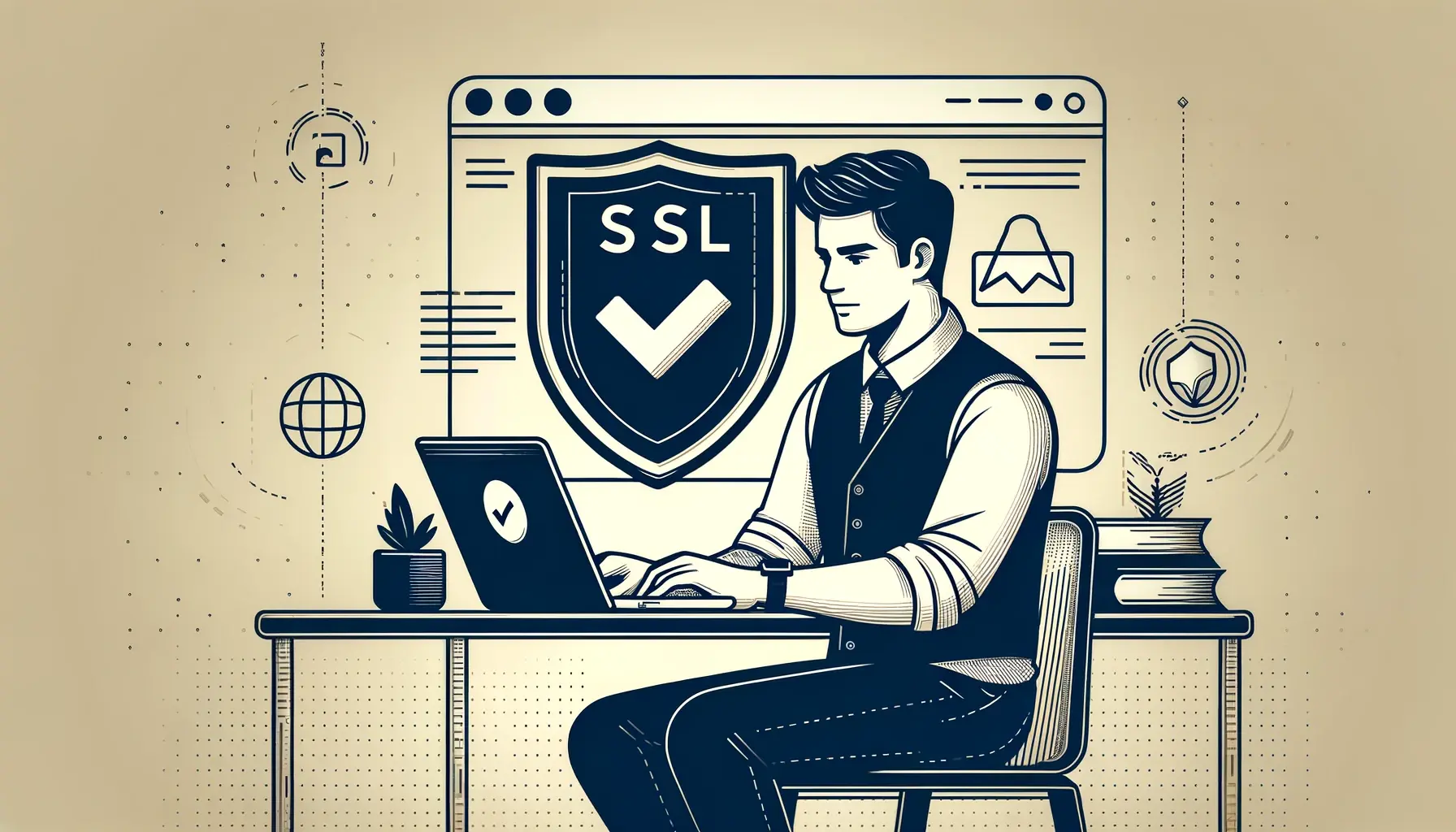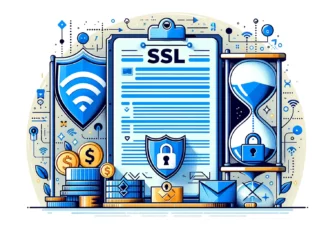
How to get an SSL certificate is one of the first questions that pop up when you’re about to launch a new website for the first time. However, if you need to learn your way around hosting and web servers, getting an SSL certificate may seem tricky.
This article shows you how to secure your website even if you aren’t tech-savvy. We’ll guide you through the process and cover all the essentials so that your site remains secure and accessible to everyone.
How to Get an SSL Certificate?
To obtain an SSL(Secure Sockets Layer) certificate, you should follow a proven, step-by-step process that ensures you get the perfect cert for your project. It starts with choosing the right SSL type, selecting a trusted certificate authority, and generating a Certificate Signing Request.
Sounds too complex? Don’t worry! We’ll explain each step so that you know exactly how it works.
1. Verify Your Website Information
So, why verify your website information before choosing an SSL certificate? Imagine you’re sending a package through the mail. You want to ensure it’s going to the correct address and that the recipient is who they say they are. The same goes for your website and its SSL certificate.
Before picking an SSL cert, the information on your website should match the information you provide when applying for the certificate. Details like your domain name, organization name, and contact information must coincide with the info you provide when requesting the certificate.
This way, the Certificate Authority (the entity that issues the certificate) will verify domain ownership and your legal identity, if applicable to your case.
Mismatches between the information on your website and the details in the SSL certificate will cause browser warnings or errors, leading to confused visitors.
2. Choose the SSL Certificate Type
Choosing the proper SSL certificate depends on your website’s nature and requirements. SSL certificate types vary in validation levels and coverage, offering different levels of security for specific scenarios.
A Domain Validation SSL certificate would suffice for small business websites or personal blogs where only one domain is in use. This type of certificate secures a single domain name (e.g., www.yourwebsite.com) and is typically the most cost-effective option.
If you have multiple websites, a multi-domain SSL certificate would be the appropriate choice. This certificate type allows you to secure multiple domains (e.g., yourwebsite.com, yoursecondwebsite.com, shop.yourwebsite.com) with a single certificate, simplifying management and cost.
For businesses involved in financial transactions or handling sensitive data, such as e-commerce websites or online banking platforms, Organisation Validation certificates and Extended Validation certs are a viable option. These certificates undergo stringent validation processes, providing the highest level of trust and security.
Another SSL option, especially for larger websites with numerous subdomains, is the wildcard SSL certificate. It secures one domain and an unlimited number of its subdomains. For instance, a wildcard certificate issued for *.yourwebsite.com would cover www.yourwebsite.com, blog.yourwebsite.com, shop.yourwebsite.com, and any other subdomains.
3. Choose a Certificate Authority
When looking for a suitable SSL certificate, you should also consider the certificate authority that issues it. First and foremost, consider the CA’s reputation and trustworthiness.
Look for well-established CAs with a history of reliability and security. At SSL Dragon, we’re partners with the leading CAs in the industry, which have years of experience in providing first-class security solutions.
Next, consider the cost. While you don’t want to compromise security, find a CA with competitive pricing for their services. Compare the pricing structures of different CAs and explore the number of domains covered and the level of validation required. Additionally, consider the range of SSL certificates offered by the CA.
Lastly, pay attention to the CA’s validation process. Different CAs may have varying levels of validation, ranging from basic domain validation to extended validation, which involves more thorough checks.
Depending on the nature of your website and the level of trust you want to establish with your visitors, choose a CA that offers an appropriate validation process. Here are the top leading CAs:
- Sectigo offers a comprehensive suite of cybersecurity solutions, including the cheapest SSL certificates on the market. Its focus is on automation and scalability for businesses of all sizes.
- DigiCert is the leader in high-assurance digital certificate issuance and management, providing top-notch security solutions with a strong emphasis on usability and customer support.
- GeoTrust provides affordable SSL certificates tailored for small — to medium-sized businesses. It offers quick issuance times, straightforward validation, and a generous warranty for added peace of mind.
- Thawte is renowned for its globally trusted SSL certificates, offering robust encryption and rigorous authentication processes to instill confidence in online interactions.
- GoGetSSL offers budget-friendly SSL solutions with hassle-free issuance processes. It caters to websites and businesses of all sizes and ensures strong encryption for secure online transactions.
4. Generate the CSR (Certificate Signing Request)
Once you’ve selected a reliable certificate authority, it’s time to roll up your sleeves and dive into the technical part of the process: generating the CSR. A CSR or Certificate Signing Request is a block of encoded text that contains your certificate’s public key and contact details about your server.
CSR creation varies depending on your server type but generally involves accessing your server’s SSL/TLS manager and following guided steps. Use our CRS generation tutorials to create and submit your CSR code. Alternatively, you can use our CSR generator tool for a quick and hassle-free CSR output.
5. Submit the CSR to the Certificate Authority
After your web server or an external tool generates the CSR containing the public key and relevant information, you must send it to the CA for validation.
The CA’s validation process can vary depending on the type of certificate and the CA’s policies. It verifies the information provided in the CSR to ensure the web server owner’s identity and legitimacy. This verification can include domain ownership and organization details; sometimes, the requester can even be contacted directly.
Once the CA has confirmed ownership and validated the information in the CSR, it issues the digital certificate via email. Check your inbox and download the archived folder sent by the CA.
The ZIP file contains all the necessary SSL installation files, including the primary certificate and the certificate authority bundle, as well as the root certificate and any intermediate certificates for validating the chain of trust.
The entire process of submitting a CSR to a CA, including validation, typically takes anywhere from a few minutes to a few business days, depending on the validation level.
6. Install the SSL Certificate
Once you have the certificate files, the next step is to upload them to your website server. You can do it via your web hosting dashboard or an FTP (file transfer protocol) client. However, since there isn’t a universal installation method, each server or email client has internal rules and guidelines regarding the SSL certificates.
After uploading the SSL files to your website server, you should configure your SSL settings, update your server’s configuration files to point to the location of the certificate files, and specify the appropriate SSL protocols and ciphers to use.
But sometimes, you may need to install the certificate manually, especially if you’re managing your own server infrastructure. Check our SSL installation tutorials for more details.
How to Get a Free SSL Certificate?
Getting a free SSL certificate is easier than you might think! You can obtain one through Let’s Encrypt. Let’s walk you through two ways to get one:
- Through your web hosting company
- By manually installing it using Certbot.
1. Through Your Web Hosting Provider
Many web hosting providers offer free SSL certificates as part of their hosting packages. When you sign up for hosting, they often include an option to enable SSL for your website. It’s usually just toggling a setting in your hosting account dashboard. Once you do that, your website will be secured with its own SSL certificate, keeping your visitors’ data safe.
In addition to web hosting providers, alternative avenues for obtaining SSL certificates are available. For example, cloud service giants like Amazon and content delivery networks (CDNs) like Cloudflare offer free SSL certificates. If you use their services, you can benefit from comprehensive support and resources, and managing SSL certificates becomes more efficient, enhancing website security seamlessly.
2. Manually Installing Let’s Encrypt with Certbot
If your hosting provider doesn’t offer free SSL certificates or you prefer to manage things yourself, you can still get a free cert directly from Let’s Encrypt. Here’s how:
- Install Certbot: Certbot is a tool for setting up SSL certificates on your web server. You can download it from the Certbot website.
- Run Certbot: Once you have Certbot installed, you’ll run it on your server. It will guide you through the process, step by step, asking you a few simple questions about your domain and web server software.
- Automatic Configuration: Certbot will automatically configure your web server to use the SSL certificate it generates. You don’t need to worry about technical details – Certbot handles everything!
- Renewal: Let’s Encrypt SSL certificates expire after a few months, but Certbot can automatically renew them for you. Once you’ve set it up, you can forget about it and rest assured that your website will stay secure.
Whether you go through your hosting provider or use Certbot, it’s a simple process that anyone can do, even if you’re not a tech whiz!
Bottom Line
Now that you know how to get an SSL certificate, you can easily select the ideal option for your website. Since SSL certs are mandatory for all sites, regardless of size and category, you should add them preferably before launching your website.
An SSL certificate installed and configured correctly will keep visitors’ data safe and enhance their browsing experience. Web browsers display SSL certificate errors if the connection is not secure. To avoid such security warnings, obtain an SSL certificate from a trusted free or commercial certificate authority.
Save 10% on SSL Certificates when ordering today!
Fast issuance, strong encryption, 99.99% browser trust, dedicated support, and 25-day money-back guarantee. Coupon code: SAVE10



























